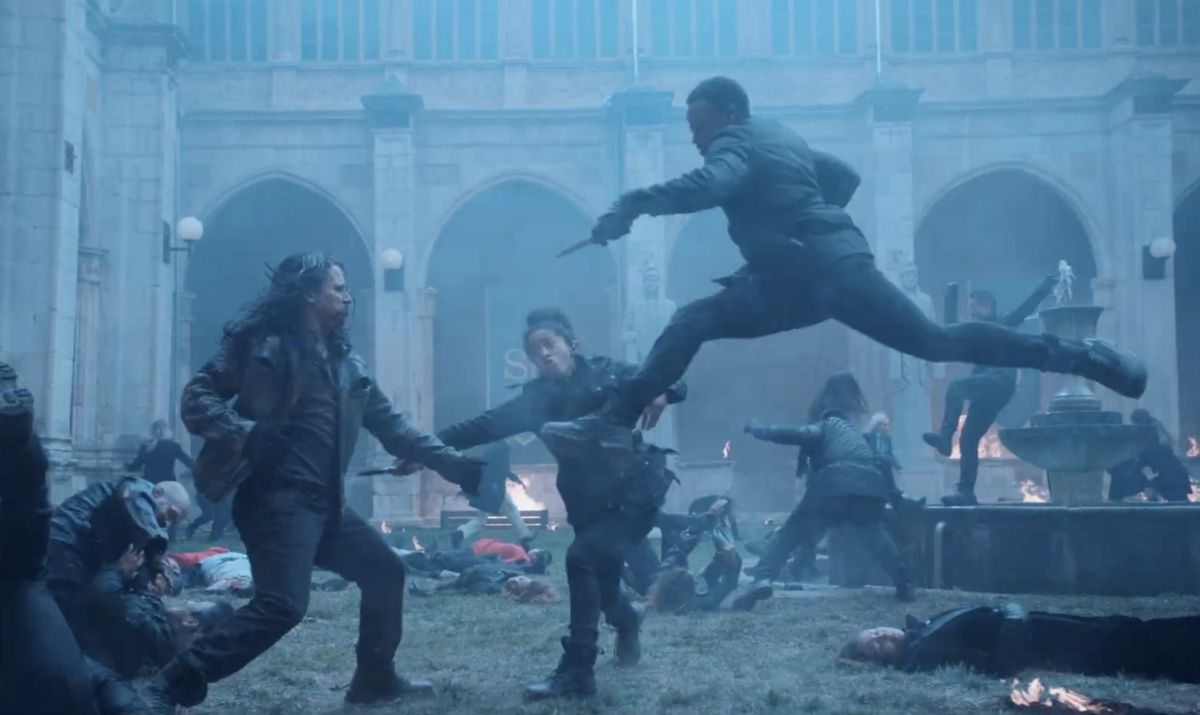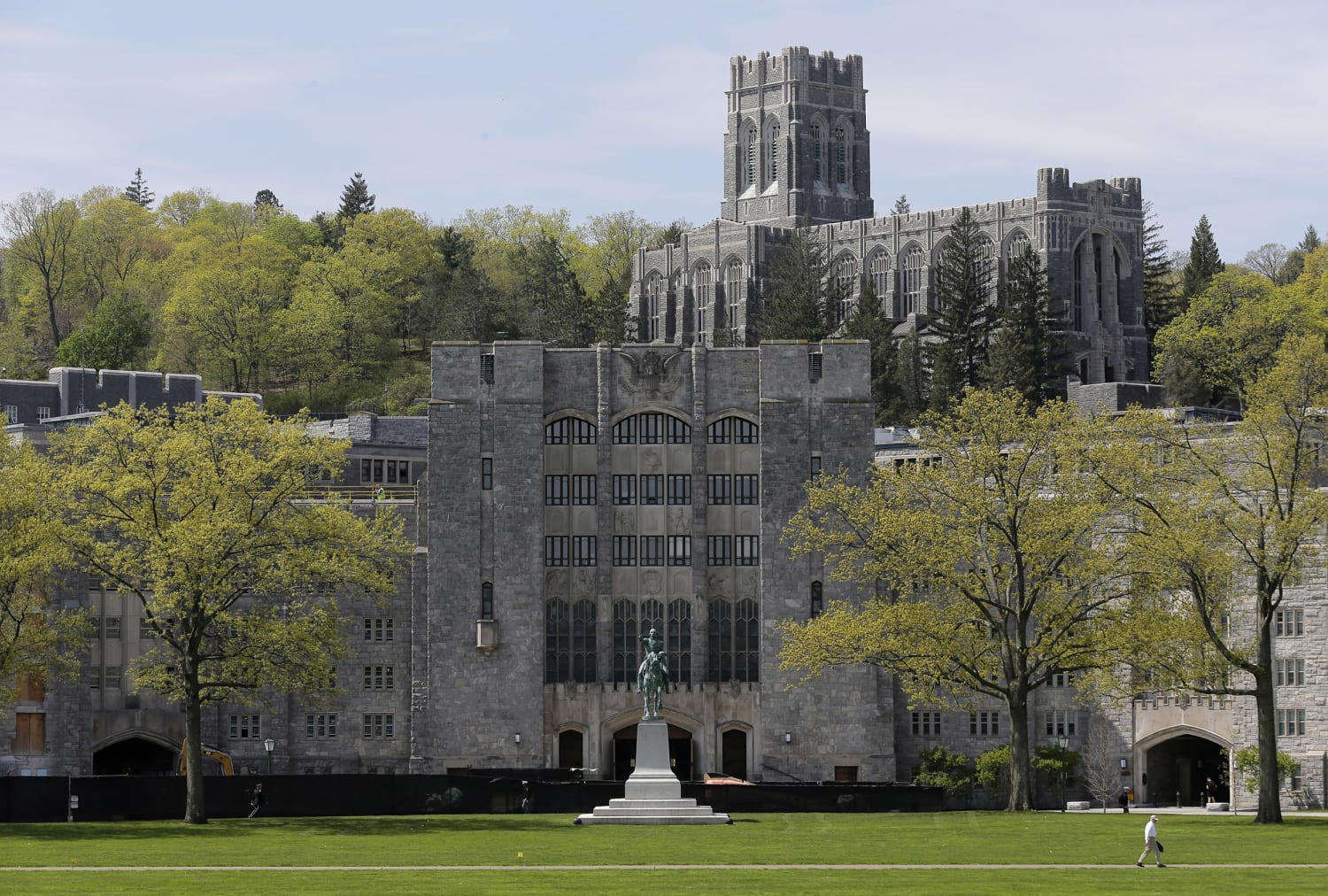Peacock Military Academy - In 1942, members of the Pike Military Academy Monkey Training Team - an acrobatic unit without a monkey - demonstrate their riding skills during the annual exhibition. Courtesy of UTSA Special Collections: Show more Show less
2 of the 4 officers of the Peacock Military Academy Class of 1954 pictured on this page from the school's yearbook include Kumari Elizondo, pastor of the San Fernando Cathedral and professor of Hispanic theology at the University of Notre Dame. He was voted "Most Studio". John Moore Jr. Show more Show less
Peacock Military Academy

Instructor John Moore Sr. demonstrates a rocket launcher in this photo from the 1954 Pike Military Academy yearbook "The Cadet." The yearbook is dedicated to Moore and Wesley Peacock Jr., longtime principals of the school his father founded. John Moore Jr. Show more Show less
The Stars Shined Near Mission San Jose
4 of 4 students from Jove Unit scaled a climbing wall during Pike Military Academy's 1948 Dress Parade and Acrobatic Ride, the second year it was on the official fiesta calendar. Courtesy UTSAU Special Collections Show more Show less
In the mid-1950s, my father was a faculty member at Pike Military Academy. The Woodlawn Lake campus, located between Cincinnati, Wilson, and Woodlawn, is now a Salvation Army residential and social facility. The school was highly respected in its day and many graduates became prominent in the San Antonio community. I was very young when my father was at Peacock, but I have many fond memories of campus life, especially the annual parade during Fiesta, which featured performances by the Jove Unit and the Monkey Drill Cavalry Team.
Class of 1954 named "Cadet" by my father and Colonel Wesley Pike Jr. I would appreciate learning more about the history of the school and the Peacock family
It was the kind of school that could only have existed in its own time, which was 1894 to 1973 – a relatively short period that covered light years of social change.
Search Continues For Missing West Point Cadet
When Wesley Peacock Sr. came to San Antonio in 1893 to become Uvalda's superintendent of schools, he too decided to start his own private school and name it after himself, all at the age of 29 without much experience. . (Two previous jobs would suffice—a teacher at Jasper, principal at Uvalda.) His wife, Celine, and their two-year-old son, Wesley Jr. At the Tower, Newcastle sought a site in the densely populated West End (now Woodlawn). ), because it looked promising and was served by a tram line
In the San Antonio Light, December 10, 1894, he placed an economical but very confident advertisement for his new venture, the Peacock School for Boys: “Number limited to 90. Day students $8 per month; Half fare by car from city (on road). Practical Education Prepare youth for college I myself give all the instructions Wesley Pike, Ph.B., University of Georgia. "
That brief speech somehow inspired parents to send nine boarding students and 17 day students to first grade, according to school records in the Texas Handbook. Ultimately, although it acquired 20 acres and built programs, Pike had to limit its enrollment to 200 students from several states, territories and foreign countries, particularly Mexico.

Dwight Eisenhower, who coached the Pike Military Academy football team while stationed at Fort Sam Houston in 1914, played on the West Point team. Here, circa 1912, the future president is third from left and future D-Day field commander General Omar Bradley is second from right. Courtesy Fort Sam Houston Museum
Peacock Military Academy
It was not a faith-based institution, unlike many in San Antonio at the time, and it was not originally a military school, but Peacock soon caught on to the trend.
"A wave of patriotism during the Spanish-American War created 83 military schools in the United States from 1898 (the war years) to 1907," says John A. Coulter. In addition to Pike's, which opened in San Antonio at the turn of the last century, Coulter's books are listed in the State-Appendix: The Texas Military Academy (later the Texas Military Institute) was founded by the Episcopal Diocese of West Texas Coulter Wesley Jr. in 1903. Before the Pike School was converted into a military school in 1900, it wore "(Admiral George) Dewey style uniforms."
In 1902, advertisements called it a "Boys' School for Peacocks" but the United States Military Academy (West Point) indicated it was a "military school" with pictures of boys (ages 8-22) wearing uniforms like cadet caps. And a jacket from that period Since 1906 the school has been known continuously as Pike Military Academy or PMA. When "The Immortal Alamo" was filmed in 1910, the cadets' uniforms allowed Pike students to play Mexican soldiers in scenes from the Battle of 1836. Future General Dwight D. Eisenhower was assigned to train. In 1915, Peacock was stationed at Fort Sam Houston
Pike's military identity was quickly strengthened in the early 20th century, with its corps of cadets serving with the US Army and the new Veterans Administration (later Administration) leasing space on campus in the 1920s as a rehabilitation center.
Alumni Review 2008 Issue 4 By Vmi Alumni Agencies
The founder's two sons, Wesley and Don - who took over the school after their father left office in 1926 - went on to distinguished military careers and served in the mostly male corps. Students paraded in fiestas—wool uniforms and all—and Woodlawn neighbors awoke to bugle calls and held regular "dress parades" that honored the prowess of Pike cadets at quarters drill.
Most memorable, however, were some elite units that displayed some skills that San Antonians are unlikely to see anywhere else.
One was the school's famous monkey drill team, a cavalry team that had to be believed (possible at 25:41 in KLRN-TV's "Remember San Antonio: The Good Times," available on the PLR website, www.pbs). .org) It was a cadre of experienced hands-free (sometimes), helmet-less riders who trained more than 40 horses in school stalls until they were ready to perform acrobatic stunts that thrilled audiences at local horse shows.

The name Crack Team comes from the equestrian tradition of mixing familiar tricks or "monkeys" and moves in a spectacular improvised sequence.
After Two Years Of Turmoil And Division, Enrollment Plummets At Nation's Famed Military College
While serving at Fort Clark, a cavalry post near Brackettville, Don Peacock was inspired by such a team and returned home to form the first PMA Monkey Drill Team.
In this undated photo, these cadets from the Pike Military Academy wear their school uniforms, with accessories to depict the Mexican Army, from the 1911 film "The Alamo" Additionally, promotional materials and press releases for the film still exist, but the film's No copy itself is known to exist Courtesy: Pike Military Academy Alumni Association
"The typical squad consisted of 10 to 14 boys and a few 'spare parts,'" says Donna Peacock in "Parade Rest: Book One, Pike Military Academy, 1894-1941." Using unusually long reins and "stiff pads" instead of saddles, riders practiced stunts with "Roman riding," standing and riding two or more horses at a time.
Spectators at an inter-school riding exhibition (described in this column, April 2) did not know what to expect from the program offerings for the "Monkey Drill Team," A Story of Light, May 9, 1937 Six horses changed saddles and galloped. As the young riders mounted their horses, they moved to a spectacular stunt of riding two horses at once, recalling a performance by the Fort Clark Monkey Drill Team. Last summer at the (Texas) Centennial (Dallas)." The show was pretty cool coming from a school kid, says The Light. The guys put the spice in a full-day program that was garden-variety for lack of variety.
Walpole Police Officer Airlifted After Motorcycle Crash
In a typical show finale, says Donna Peacock — Don Peacock's daughter — riders form a pyramid of four boys on four horses, with the fourth and youngest boy standing on the shoulders of the middle member of the team holding an American flag. Ending the routine with a daring backflip by the tallest student, who was "caught by the pants by standing peers".
The troupe performed at rodeos and horse shows in Texas and Mexico from 1935 to 1957, and a boarding school was a great advertisement for whipping a boy into the shape of a biscuit.
Another striking feature on field day was the Peak Jove Unit Boys
Military drone range, laser range finder military, military range bags, military range targets, long range military radio, military radio range, military range finder, military long range binoculars, range rover military discount, military range rover, range of military drones, military range bag

0 Comments